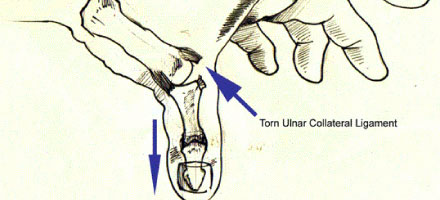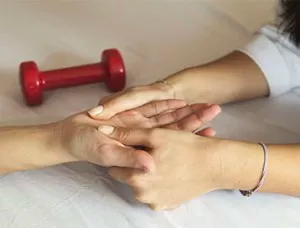What is a sprained thumb?
By Nigel ChuaOften commonly known as
- Goalkeeper's Thumb
- Skier's Thumb
- Basketballer's Thumb
A sprained thumb is a common cause of thumb injury, pain and swelling.
It has been called Goalkeeper's Thumb due to the injury sustained when a goalkeeper is hit on the thumb by a ball flying towards them. Skiers may also experience a similar injury when their ski sticks become jammed in the snow or objects, yanking the thumb backwards.
A sprained thumb refers to damage to the ulnar collateral ligament (UCL), which can mean a partial or full tear (see image below)

This injury is not exclusive to skiers or goalkeepers, and can happen to anyone when enough backwards force is applied to the thumb and it is moved too far from the hand. Some of our patients have experienced this injury by falling or getting their thumb caught on something.
SPRAINED THUMB SYMPTOMS
With mild sprains, patients may experience
- pain with use
- thumb joint stiffness
- instability
- edema and swelling
- thumb weakness affecting pinch and grip or typing
In a severe case of a sprained thumb, you will often notice immediate swelling and bruising that increases from the moment you injured your thumb. In some cases, the affected area may even turn bluish-purple in color.
If you sprained your thumb more than three months ago and the strength, stability and function hasn't fully returned (termed as chronic), you may find thickening of the joint when you feel and palpate the area.
The thumb joint may feel more loose and unstable when compared to the other non-injured thumb joint, and you may find increased difficulties when pinching or manipulating small objects between the thumb and index finger.
SPRAINED THUMB HAND PHYSIOTHERAPY TREATMENT

Our senior hand therapist will first do an in-depth assessment on your sprained thumb, to check its range of motion, function, pain score and injury severity.
If the thumb joint is very unstable, we may need to prescribe a custom-made thumb and wrist splint to protect the torn thumb ligament, which needs to be worn a minimum of 6 - 12 weeks to prevent aggravation of the injury and encourage the torn parts to connect and heal well.
In the early phase of therapy, we will focus on
- stabilizing the injury with splinting
- cold therapy to decrease the swelling and pain
- ultrasound therapy to accelerate soft tissue healing
- protected/gentle mobilization to prevent adhesions and encourage gliding of delicate thumb and hand structures.
Once the injury is less acute, our senior hand therapists will gradually
- introduce more active ranging exercises
- work with you on progressive strengthening
- aim for 100% range of motion, strength and stability.
A dedicated senior physiotherapy and hand therapy program in Phoenix Rehab will likely help you to resolve your sprained thumb condition within six to twelve weeks.
Browse other articles by category
Physiotherapy for Knee Pain Physiotherapy For Slipped Disc Physiotherapy for Neck Pain PHYSIOTHERAPY
PHYSIOTHERAPY
 Hand Therapy
Hand Therapy
 Alternative
Alternative
 Massage
Massage
 Traditional Chinese Medicine Treatment
Traditional Chinese Medicine Treatment
 Rehab
Rehab
 Physiotherapy For Lower Back Pain
Physiotherapy For Shoulder Pain
Orthopedic Doctors, Insurance & Healthcare
Physiotherapy For Upper Back Pain
Frozen Shoulder
Physiotherapy for Back Pain
Physiotherapy For Lower Back Pain
Physiotherapy For Shoulder Pain
Orthopedic Doctors, Insurance & Healthcare
Physiotherapy For Upper Back Pain
Frozen Shoulder
Physiotherapy for Back Pain

 Whatsapp us now
Whatsapp us now